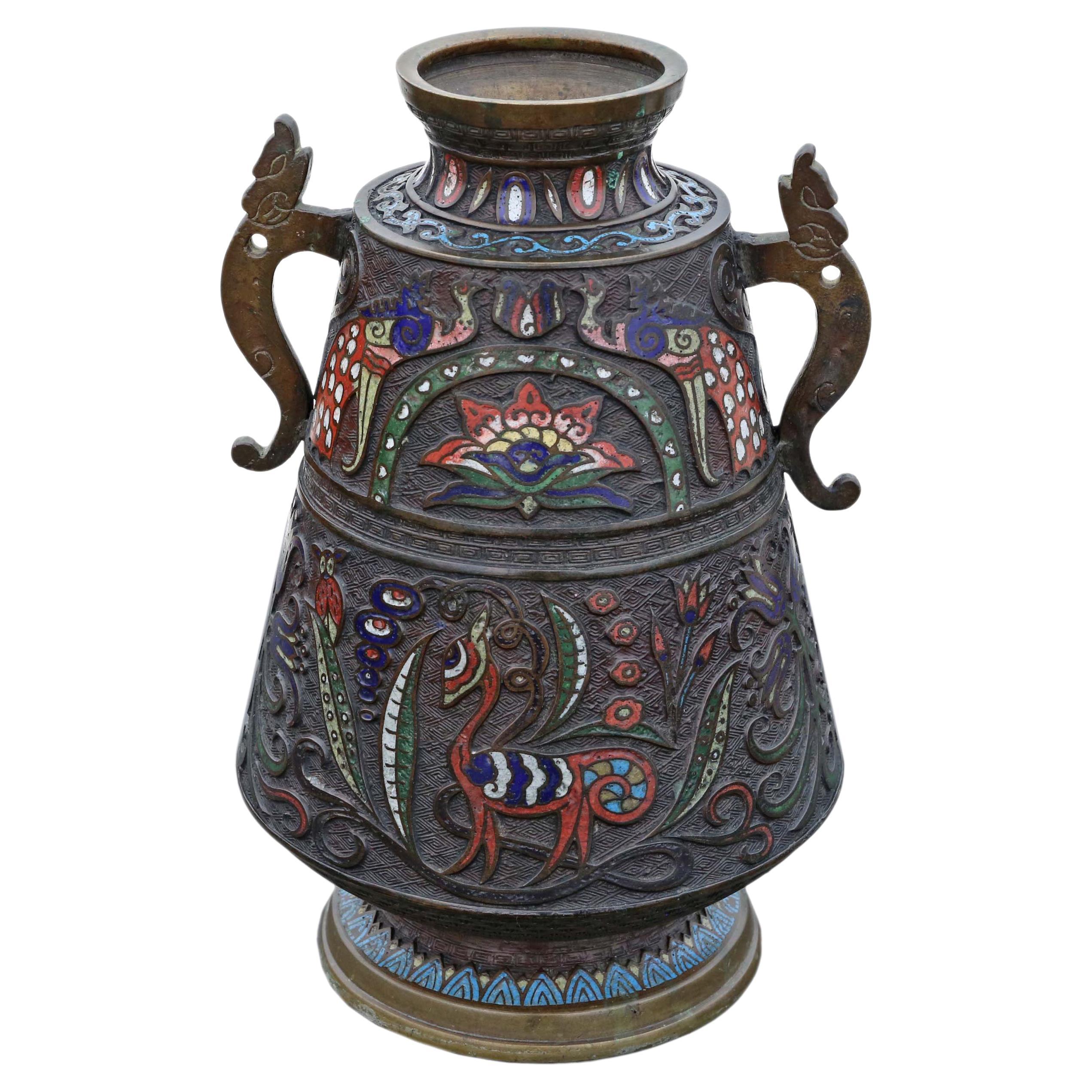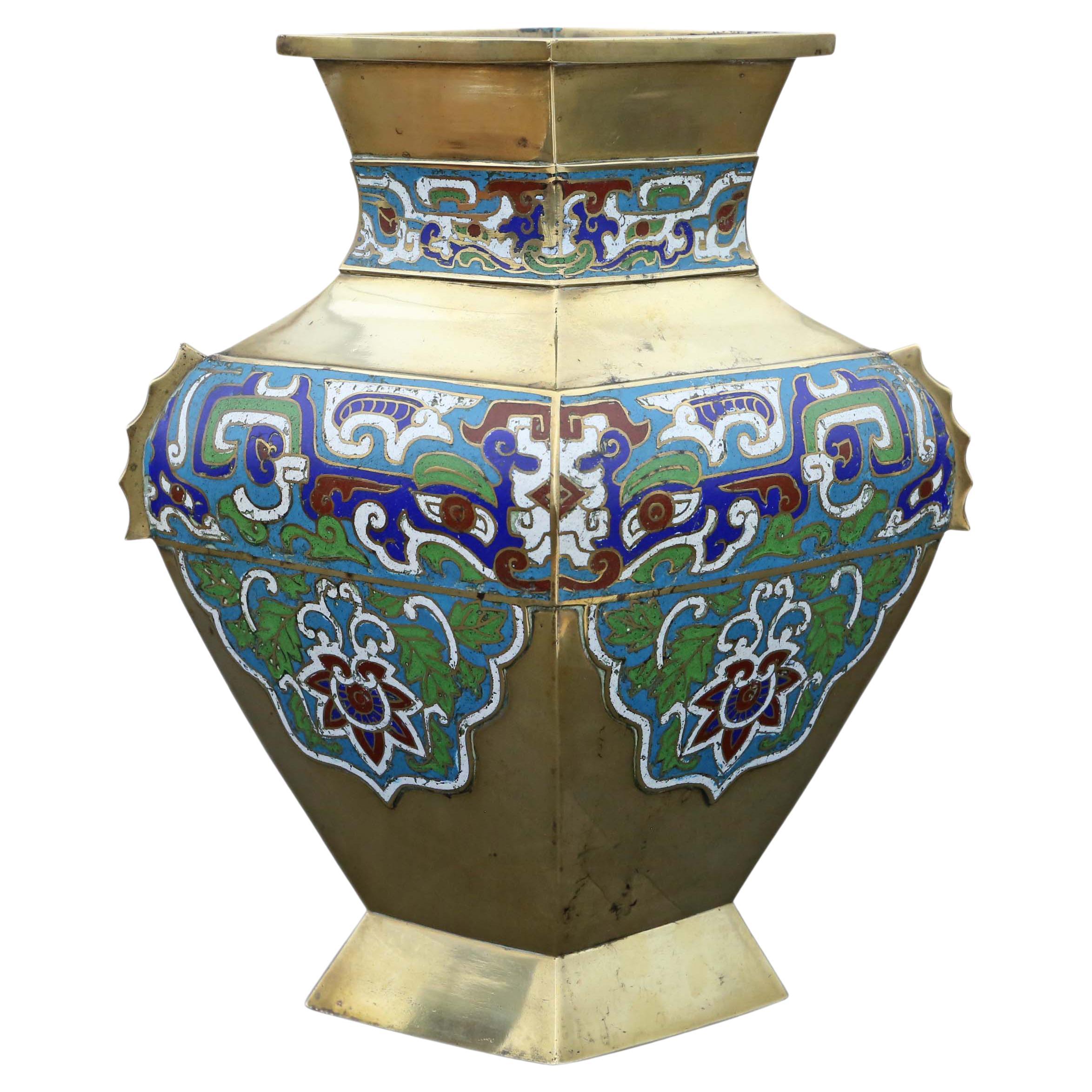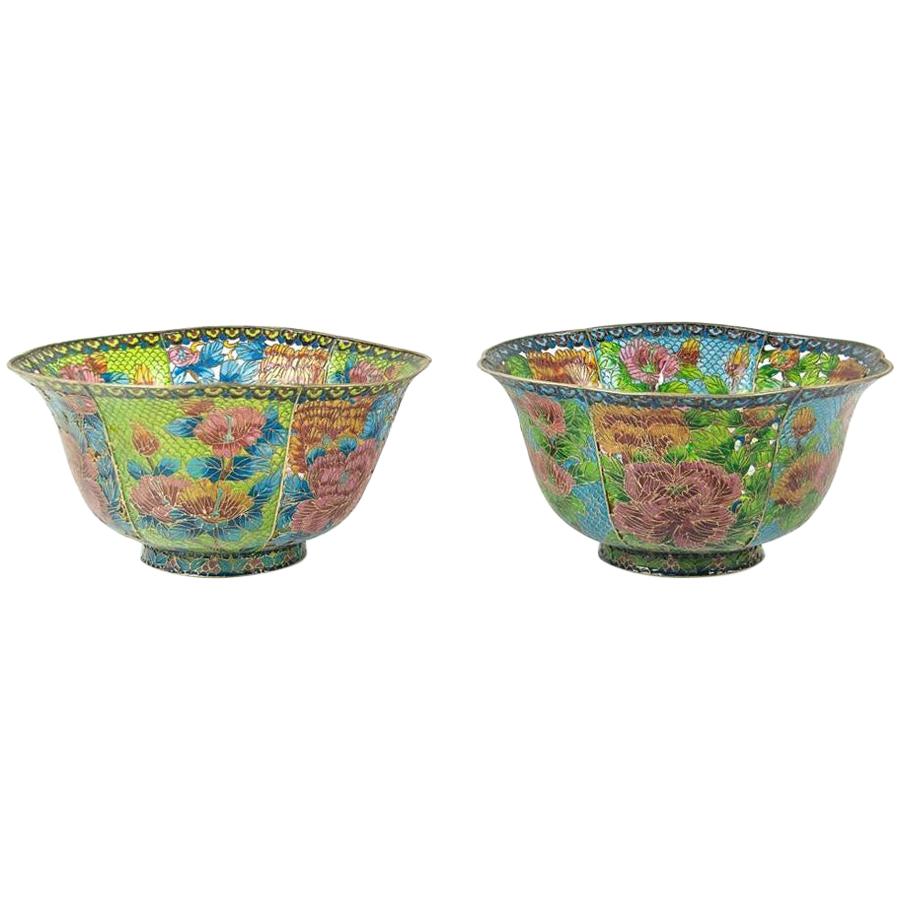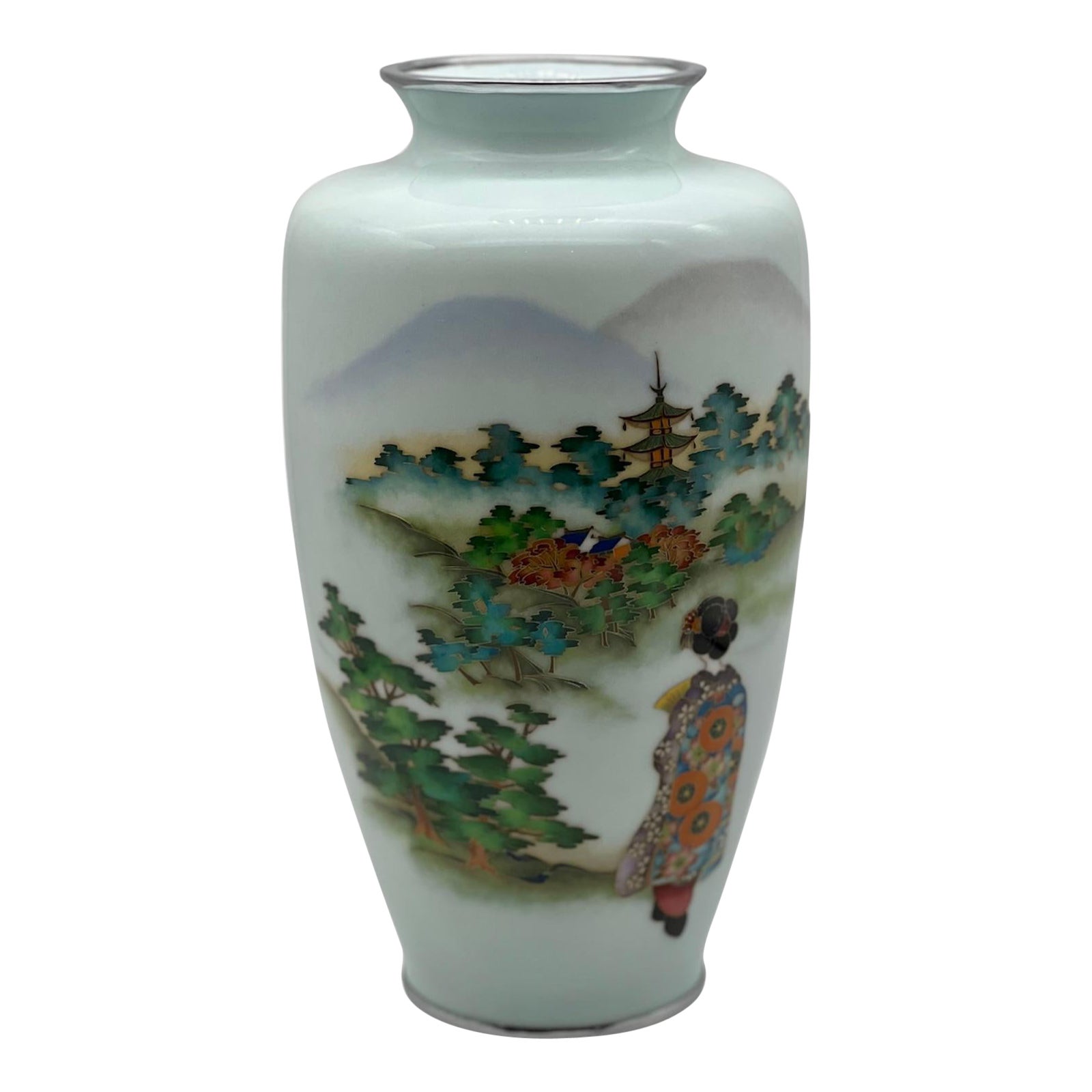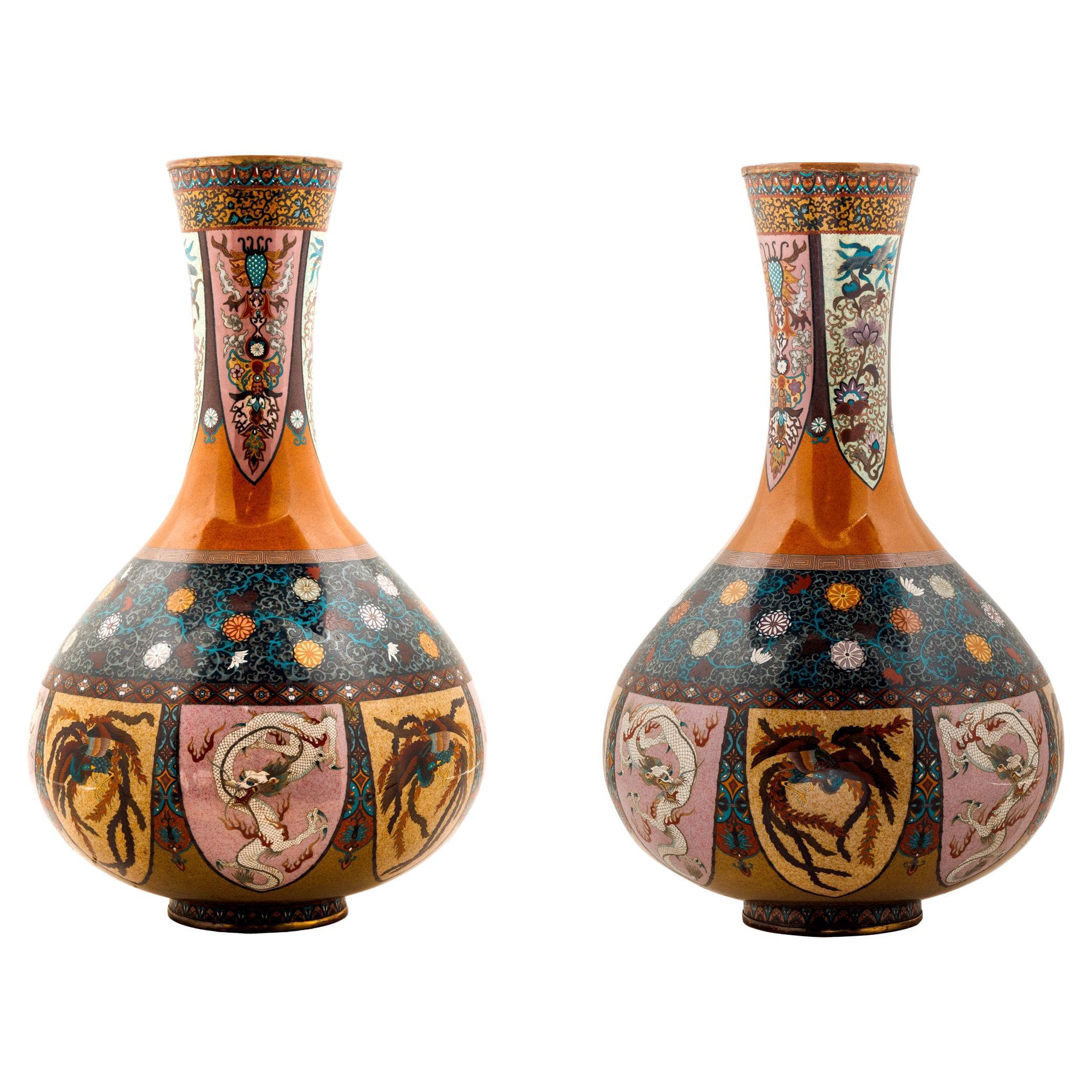Items Similar to Large Oriental Champleve Cloisonne Urn on Stand
Want more images or videos?
Request additional images or videos from the seller
1 of 15
Large Oriental Champleve Cloisonne Urn on Stand
About the Item
Presenting a beautiful and very high quality large oriental champlevé cloisonné urn on stand.
Late 19th or early 20th century, circa 1890-1910.
Probably Japanese in the Archaistic Chinese style.
Marked, but we cannot decipher the mark.
Stunning cloisonné work with enameled flowers of various species. Gorgeous turquoise, blue, green, red, white and orange enamels. Stunning chasing on the solid brass/bronze urn. Lovely original wooden stand.
2 birds of paradise on either side of the urn with ringed handles.
Has been heavily 'cleaned' over the years which may have resulted in the brass like patina, rather than a more natural bronze patina.
Provenance: From the private collection of a former New York Art Dealer who moved to Dallas in the 1980s.
- Dimensions:Height: 21.5 in (54.61 cm)Width: 12 in (30.48 cm)Depth: 12 in (30.48 cm)
- Style:Japonisme (Of the Period)
- Materials and Techniques:
- Place of Origin:
- Period:
- Date of Manufacture:1890-1910
- Condition:Wear consistent with age and use. Good condition. Appears to have been overly polished/cleaned by previous owners giving it a more brass appearance than the natural bronze patina. Left alone, the patina should return.
- Seller Location:Dallas, TX
- Reference Number:1stDibs: LU3978116125051
About the Seller
4.9
Platinum Seller
These expertly vetted sellers are 1stDibs' most experienced sellers and are rated highest by our customers.
Established in 2015
1stDibs seller since 2018
348 sales on 1stDibs
Typical response time: <1 hour
- ShippingRetrieving quote...Ships From: Dallas, TX
- Return PolicyA return for this item may be initiated within 7 days of delivery.
More From This SellerView All
- Japanese Meiji Champleve and Bronze UrnLocated in Dallas, TXPresenting a gorgeous Japanese Meiji Champleve and bronze urn. Made in Japan during the Meiji Period circa 1880. The body of ...Category
Antique Late 19th Century Japanese Meiji Metalwork
MaterialsBronze, Enamel
- Antique Indian Dhokra Horse and Rider SculptureLocated in Dallas, TXPresenting a lovely antique Indian Dhokra horse and rider sculpture. Probably from the late 19th or early 20th century as is evidenced by its natural patina and clear evidence of age. It depicts an Indian Warrior with a sword in his right hand mounted on his horse/steed. The warrior is in classical and ancient Southeast Asian Indian attire and he holds the horse’s reins in his left hand. The body of the horse is a series of lines (in the Classic Dhokra Style) and it has a tribal headdress...Category
Antique Late 19th Century Indian Anglo Raj Metalwork
MaterialsMetal
- Japanese Meiji Period Sterling Silver 2 Handled Basket by Katsu MiyamotoBy Miyamoto Shoko 1Located in Dallas, TXPRESENTING a GORGEOUS, VERY HIGH QUALITY and EXTREMELY RARE piece of Japanese Meiji Period Sterling Silver 2 Handled Basket by Katsu Miyamoto. EXQUISITE, EXCEPTIONAL, RARE & IMPORTANT! This is definitely a Meiji Period piece due to the fact that it is marked with the sterling silver mark “jungin”. The Meiji period was from 1868 to 1912 and in 1928 a law was introduced in Japan compelling the use of decimal marks for silver. This pre-dates that decimalization law. We are of the opinion that it is from circa 1900. Miyamoto Shoko was founded in 1880 as the first silverware specialty shop. In 1899, Miyamoto Shoko’s silverwares were ordered by the family members of the Emperor of Japan, and to this day, they are making fine and graceful handicrafts with skillful craftsmen. Loved by numerous customers since the Meiji era, Miyamoto Shoko’s products have also been given to Princess Mako and Princess Kako of Akishino, as well as Princess Aiko Toshinomiya, on their birthdays. Katsu Miyamoto (宮本勝), in 1880, in order to increase the sales of tobacco and cigarettes to foreigners founded the Moyamoto Shoko company, which produced different silverwares in general and particularly silver cigarette cases. Miyamoto’s first name, Katsu (勝) in some sources is written as “Masaru”, since 勝 kanji can be pronounced in both ways. This basket is of the HIGHEST QUALITY imaginable! The top of the basket has the MOST GORGEOUS repousse work of flowers, probably lotus flowers, with leaves and foliage. It has an underlying chevron effect chasing, reflecting parquetry. The 2 handles are cast in the form of bamboo handles. The rim of the top likewise is cast as bamboo. The base is equally stunning in a different way! It is chased with a chevron effect, like parquetry flooring and the four feet simulate pieces of sliced bamboo with an interlinking gallery of support columns, likewise, simulating bamboo. The QUALITY of WORKMANSHIP is OUTSTANDING! The pieces weighs exactly 525 grams. This piece takes my breath away! This is one for the SERIOUS COLLECTOR of EXQUISITE AND RARE Japanese silver. You will not find another like it, for sale ANYWHERE ELSE IN THE WORLD …… I know as I have searched! Provenance: Acquired from a Dallas Private Collector. Dimensions: 9.6 inches wide, 7.6 inches deep and 2.75 inches tall ( 7.25 inches tall with handles up) Condition: Very good. It looks like the base 4 legged gallery, has been repaired/re-attached to the base, but otherwise it is excellent and of Museum quality. The Meiji period (明治時代 Meiji-jidai?), also known as the Meiji era, is a Japanese era which extended from October 23, 1868 through July 30, 1912.[1] This period represents the first half of the Empire of Japan during which Japanese society moved from being an isolated feudal society to its modern form. Fundamental changes affected its social structure, internal politics, economy, military, and foreign relations. The period corresponded with the reign of Emperor Meiji after 1868, and lasted until his death in 1912. It was succeeded by the Taishō period upon the accession of Emperor Taishō to the throne. Solid silver pieces...Category
Early 20th Century Japanese Meiji Metalwork
MaterialsSterling Silver
- Early 20th Century Gilt Metal Thai Khon DancerLocated in Dallas, TXPresenting a beautiful early 20th century Gilt Metal Thai Khon Dancer. Made in Thailand (South East Asia) circa 1920. It features a gilt meta...Category
Early 20th Century Thai Country Sculptures and Carvings
MaterialsMetal
- 15th Century Gilt-Copper Kirtimukha Repousse PlaqueLocated in Dallas, TXPresenting a gorgeous 15th century gilt-copper Kirtimukha repousse plaque. From circa 1450 this is a stunning piece of Southeast Asian antiquity. Fro...Category
Antique 15th Century and Earlier Nepalese Archaistic Antiquities
MaterialsCopper
- Vintage Chinese Double Happiness Wedding CandlesticksLocated in Dallas, TXPresenting a lovely vintage Chinese double happiness wedding candlesticks, a matching pair. Made in China in the early 20th century of bronzed pewt...Category
Early 20th Century Chinese Archaistic Metalwork
MaterialsPewter
You May Also Like
- Antique Large Japanese Bronze Champleve Enamel VaseLocated in Wisbech, CambridgeshireAntique large quality Japanese bronze Champleve enamel vase C1900. Would look amazing in the right location. Rare large size and design. O...Category
Antique Early 1900s Japanese Metalwork
MaterialsBronze
- Antique Large Chinese Brass Bronze Champleve Enamel VaseLocated in Wisbech, CambridgeshireAntique large quality Chinese brass bronze Champleve enamel vase C1920. Four sided rhomboidal form. Would look amazing in the right location....Category
Vintage 1920s Chinese Metalwork
MaterialsBronze
- Large Meiji Period Cloisonne Enamel KoroLocated in London, GBLarge Meiji Period Cloisonne Enamel Koro Japanese, late 19th Century Height 88cm, width 76cm, depth 53cm This superb cloisonne enamel koro was made during Japan's Meiji period, and ...Category
Antique Late 19th Century Japanese Meiji Metalwork
MaterialsBronze, Enamel
- Pair of Large Chinese Cloisonné Plique-à-Jour BowlsLocated in Atlanta, GAA large pair of Chinese cloisonné enamel bowl made with the technique of plique-à-jour (means "letting in daylight" in French), a challenging method similar to small scale stained windows...Category
20th Century Chinese Chinoiserie Metalwork
MaterialsCopper, Enamel
- A Large Japanese Cloisonne Enamel vase attributed to Ando JubeiBy Ando JubeiLocated in London, GBA Large Japanese Cloisonne Enamel vase attributed to Ando Jubei. Taisho period (1912 – 1926) A large baluster Cloisonne-Enamel vase worked in musen and silver wire of varying gauge...Category
Early 20th Century Japanese Metalwork
MaterialsEnamel
- Large Pair of Japanese Cloisonne Enamel Vases Attributed to Honda YasaburoLocated in New York, NYA large pair of Japanese Cloisonne Enamel vases attributed to Honda Yasaburo, 19th century. Finley decorated with the rich enamel colors of orange and green, these vases are desig...Category
Antique 19th Century Japanese Meiji Metalwork
MaterialsCopper, Enamel
Recently Viewed
View AllMore Ways To Browse
Antique Bronze Patina
Oriental Collection
Asia Oriental
Antique Oriental Furniture Furniture
Antique Furniture Oriental
Antique Oriental Furniture
Oriental Antique Furniture
2 Birds
Asian On Stand
Century Furniture Oriental Collection
White Oriental
Oriental Antique Art
Bird On Stand
Green Blue Oriental
Red Asian Stands
New Urns
Antique Bird Stand
White Furniture Oriental
